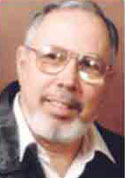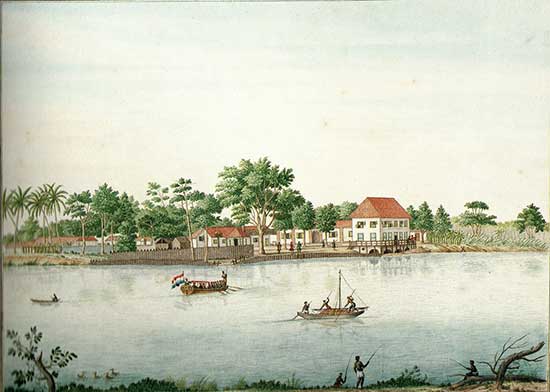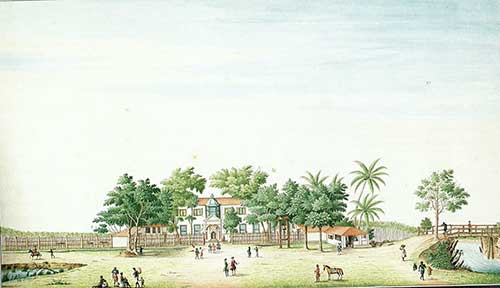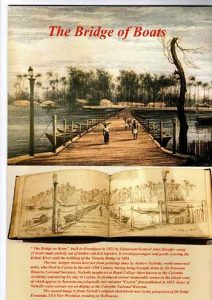Grandpa’s Grandpass – (intro By Des Kelly)
This is a good one, ladies & gentlemen. One of the famous old “Areas” of Ceylon that all of us ex-patriots should remember. Comes to me also, from a famous old Cartoonist friend, living now, in Perth, Australia. He needs no introduction and I am proud to call him a good friend.
His name is Maxwell Gerreyn, and he has written his own introduction to this interesting piece on old Ceylon.
Please read it. I feel certain that it will bring back many golden memories.

Desmond Kelly.
(Editor-in-Chief) eLanka.
Dear ALL…The title to this forward could very justifiably be my PERSONAL appellation or tribute to the district/area/city code of Colombo where my two elder brothers and myself were born and raised…The Sinhala name for the area code was Thotalanga 14 – which I believe roughly translates as `near the river/bridge’…My paternal grandfather’ previous abode when he married my grandmother is unknown to me – but to my fullest knowledge after he secured employment as the `chief’ foreman in charge of the coconut.copra oil mills of Adamjee Lukmanjees – the then millionaire(in today’s terms `billionaire’) Borah merchant tycoon located more than half-way down the long stretch that was Grandpass Road – was allocated a large residence at a heavily discounted rent a few doorstops away from the company’s premises. Grandpa and Grandma spawned a brood of ten of which my Dad was the first born and the first to pass . I was his third and youngest son and was delivered onto the world at this very residence – street number 244 – 83 summers/winters ago. Many are the wonderful and really weird and mysterious tales can I recall about the 61 years I spent as boy and young man 24 when I finally – the last of the first Gerreyns – left the home of my grandfather.. Its still the place I call `HOME’.
Today the title `Grandpass’ will most possibly be scoffed at with much derision for its apparent pretentiousness – but I believe many of you readers will weigh in on my side when one reads the history and the origins of Grande Passo – as the Portuguese – the first of now Sri Lanka’s colonisers named it…Enjoy the read below.
Grandpa’s Grandpass – by Dr Srilal Fernando
Source:Island

Though I was born in Panadura, a small village south of Colombo, my parents moved to a property in Colombo to facilitate my travelling to school. The property was located between Grandpass and Mutwal and formed part of a large estate called Mahawatte which was a grant of 58 acres to my grandfather’s grandfather’s grandfather, Renaldus D’Andrado in 1788.
Delving into the family papers, the originals of which are in the Sri Lanka National Archives, was a fascinating journey into the history of the family and the areas around Grandpass. The documents form a folio called the D’Andrado Manuscripts, and these were published in the National Archives Journal Vol II of 1984 edited by J.H.O. Paulusz – retired Government archivist. Among these papers are the Act of appointment of Renaldus D’Andrado as Mudaliyar dated January 15, 1787, his last will, a plan of partition of his estate among his descendants, and the genealogical table of the de Fonseka, D’Andrado and related families. He was also nominated as one of the executors of his will by the Maha Mudliyar, the redoubtable Nicholas Dias Abeysinghe1 a remarkable man who died in 1795. The book Chieftains of Ceyon by J.C. Van Sandon has an account of him.
All six children of my grandfather Francis Samuel de Fonseka, had land along Mahawatte Road. I grew up there, and on return from England, built a house on the lawn of my mother’s property. My grandfather however never resided in Mahawatte, choosing to live in a house called “St Patrick’s” overlooking the Kelani River, close to the former country residence of Dutch Governors. His eldest son Patrick John de Fonseka was born on St Patrick’s Day.
Grandpass derives its name from the Portuguese who called it Grande Passo, and in British times came to be known as Grandpass. Before the arrival of the Europeans it was called Nagalagam Tota implying that it was a place of crossing the Kelani River even then. The road that runs from the river is called Nagalagam Street and joins Grandpass Road which continues to Pettah and Colombo Fort. In British times and till the 1950’s, trams ran along Nagalagam Street from Grandpass to Fort. As a child I recollect travelling in this tram. This was later replaced by trolley buses which ran along Prince of Wales Avenue later named Sirimavo Bandaranaike Mawatha. The name Grandpass suggested that there existed a small pass and indeed there was one called Petit Pas. It was at the point where there was a sluice gate over the San Sebastian Canal close to the present Colombo Kachcheri. A painting of the original building De Uytvlught on the Rijksmuseum in Amsterdam shows a splendid building which in 1852 was altered and now forms the Colombo Kachcheri. A painting of the sluice gate by J.L.K. Van Dort in 1888 exists in the Royal Institute of Linguistics and Anthropology in Leidan.

San Sebastian Canal is a man made canal which connected the Kelani River to the Beira Lake. In older times the Beira Lake was much bigger than it is now, and connected to the Colombo Harbour close to the place where the old Parliament building stands. It was the most important waterway through which export produce was transported for shipping. Parts of the waterway still exists, but landfill has made it narrow and since the advent of the road transport, its commercial importance has deteriorated.
San Sebastian Canal joined the Kelani River at Grandpass and this became the hub where all produce transported along the river in flat bottom barges (Paruwas) was transferred on to the canals. Cinnamon, food, sand and building products were transported this way.
Grandpass was also the main ferry across the Kelani River. It was the main Gateway to Colombo and the caretaker of the ferry had an important role to play and became an income generating source for the Dutch Company. His duties included checking the locals for arms and ammunition. Iron, gunpowder and saltpetre could not be transported into the city and duties were imposed. Arrack transported into the city was taxed at this point. A toll was charged for the use of the ferry.
In British times it continued its importance and in 1822 the river was spanned by a “bridge of boats”, a pontoon bridge which was in use till 1895. A painting of this, by the Irish artist Andrew Nicholl in
1848 is in the Colombo Museum. An original sketch done by him, now in my possession is reproduced here. The bridge of boats consisted of 21 boats anchored side by side, and a carriageway about 500 feet long ran from Grandpass to the other side of the river. For one hour each day the land traffic was stopped and two boats moved to allow river traffic. In 1895 the Victoria Bridge was built and took its place.
There were several other ferry points across the Kelani River. One was down river near Mutwal and connected the present day Sri Wickrema Mawata to Wattala on the other side. It was called Pas Betal and was the place where the Dutch having captured Negombo entered the outskirts of Colombo. Many years later the British did the same. Other ferries existed up river at Kelani Mulla, Kaduwela and Hangwella.
Ferry Crossing at Grandpass, Watercolour, 1755, Rijksmuseum
Grandpass and its surroundings in Dutch times was the favoured area for the Governors and senior officials to build their country residences. It was easily accessed with good roads, received a cool breeze in a hot climate ,and everything grew abundantly.
Governor Rickloff Van Goens 1664-1675 had a large property which was called Van Goens Village or Van Goensdorp. His son who too became Governor improved the property. Governor Iman Falck 1765-85 had a villa in Grandpass with cinnamon planted in the garden. He encouraged the cultivation of cinnamon. Till that time what was harvested was the cinnamon growing wild.
Governor Johann Van Angelbeek 1795-1796 had a country house at Grandpass. There is a detailed description of this house in Rev. James Cordiner’s, A Description of Ceylon published in 1807.
“At grandpass stands a country seat built by the late Dutch Governor Van Angelbeek. Besides a row of offices and a handsome farmyard there are two houses of one floor each for the accommodation of the family. These lie parallel to one another, and it is necessary to pass through the first to get to the second, which is raised on an embankment of the river. The stream is seen gliding along from the windows and is broad, deep and rapid. The opposite banks are clothed in thick woods.” He also mentions that after the takeover by the British, General Hay MacDowell and his staff lived there for several months at a time.
Governor’s House at Grandpass, Watercolour, Rijksmuseum
“General MacDowell was in the habit of receiving boxes of trees and shrubs by almost every ship; and one acre and a half of ground was completely filled with them”.
He introduced Mangosteen to Ceylon and it is most likely that the first plants were at Grandpass. He is also credited with introducing many other plants, including nutmeg, cloves, apples, asparagus to Ceylon.

J.P. Lewis in his notes on Pioneers of Natural History in Ceylon says that General MacDowell on his departure in 1804 left directions with his nephew John MacDowell of the Civil Service “to give a few plants of each sort to every person who promised to nourish them”.
“His house it may be mentioned was at Grandpass, a country seat built by the late Dutch Governor Van Angelbeek”.
Lewis also mentions that Joseph Jonville, a Frenchman, was the first Superintendent of the Botanical Garden started by Governor North on the opposite bank at Peliyagoda called “Ortafoula”. Later, on Jonville’s condemnation of the first site the gardens were moved to Slave Island and named “Kew”.
Cordiner mentions that on the opposite bank of the river Governor North built a temporary bungalow where he held grand entertainments. “Excellent boats carried the party, a band and other luxuries of the feast.”.
He mentions that “on the main roads, one leading to Grandpass and the other leading to Cotta, there are many commodious houses inhabited by the Dutch and European families.
The local elite too had houses in and around Grandpass and the area leading up to Hultsdorf.
A watercolour painting of the last Dutch Governor’s house in 1757 is in the Rijksmuseum in Amsterdam. It is reproduced in Dr R.K. de Silva’s book. Two engravings, one from the front and the other from the rear is presented in Valentijn’s book of travel in 1726.
The location of the house is described in Dr R.K. de Silva’s book as North East of the present Madampitiya Road and the ferry at Grandpass. The scene shows the house looking North East from Nagalagam Street with the San Sebastian Canal on the right with the bridge over it.
Incidentally, the Town house in Colombo Fort belonging to the last Dutch Governor Van Angelbeek became the house occupied by General MacDowell for a time. It became vested in the British Government and became the King’s House, Queen’s House and now President’s House.
Large houses with extensive land, with numerous specimens of flora and fauna dotted the area extending up to Mutwal.
In British times, there is a detailed description of the Whist Bungalow in Ernst Haekel’s book “A Visit to Ceylon.” He stayed there for two weeks, a guest at the then owner Stipperger, the agent for Austrian Lloyd Shipping Company. Haeckel, a naturalist and Professor in the University of Jena, gives a very detailed description of the house and the gardens. His detailed botanical drawings inspired the Spanish Architect Antoni Gaudi. Another house in Mutwal still preserved is Elie House.
This was the preferred area of residence well into the 19th Century with schools such as St Thomas’ College starting off there. The then Catholic Bishop of Colombo acquired land to start St Joseph’s College, but eventually chose a more central location on cheaper land reclaimed from the Beira Lake. In the late 19th Century as cheap land cleared of cinnamon became available more people moved to the new area. Another factor was that the move of the main port from Galle to Colombo and the replacement of sailing ships to coal driven steam ships. This required coal bunkering. Coal was stored in old ships along the coast line near Mutwal and the wind blew the coal dust on to the shore and this became very unhygienic. Added to this, was the large scale commercialisation of the buildings leading to overcrowding and the large houses and gardens being carved up. Property prices had escalated and it was much more affordable to buy property in the recently opened Cinnamon Gardens.
Grandpass is described in most of the books on early Ceylon including the book by Robert Percival in 1803, the first book on Ceylon after the British take over.
Governor North brought in Robert Arbuthnot as the Chief Secretary for Ceylon. He in turn brought his brother George as Deputy Secretary, George kept a detailed diary which was later published by his heirs. He describes the houses occupied by General MacDowell, as quoted in the article “When North was Governor” by J.P. Lewis in the Ceylon and Antiquarian Literary Register in 1923.
An article by L.T. Gratien “Colombo in the 17th Century” in the C.A.L.R. States “at Grandpass was a noble house where Kandyan envoys used to reside when they visited Colombo. Later on, a house on Wolvendaal hill was set apart for the convoys and the house at Grandpass became the Dutch Governor’s country seat. There begun the cultivation of silkworms which gave Sedawatte its name and here in the next century was formed the first Cinnamon Estate.”
With the passage of time the areas around Grandpass has become less than salubrious. Large warehouses have come up and the area commercialised. The slums have been replaced by low to middle class housing complexes. It is no longer “Grand” and many will “Pass” by without any inkling of the rich history of the area.
References
1. The d’Andrado Manuscripts – J.H.O. Paulusz
The Sri Lanka Archives Volume 11 1984
2. Notes on some Singhalese families
Paul Pieris
3. The Chieftains of Ceylon – J.C. Van Sanden
1936
4. Changing Face of Colombo R.L. Brohier
1984
5. Old and New East Indies
Francois Valentijn 1724
6. Illustrations and Views of Dutch Ceylon 1602-1796
Dr R.K. de Silva and WGM Beumer 1988
7. Website deFonseka.com – Courtesy Jayashanth deFonseka
8. Account of Ceylon Robert Percival
1803
9. A Description of Ceylon – James Cordiner 1807
10. A Visit to Ceylon – Ernst Haekel 1883
11. When North was Governor – J.P. Lewis
Ceylon Antiquary and Literary Register 1923
12. Colombo in the 17th Century – L.J. Gratien
Ceylon Antiquary and Literary Register Volume VIII Part IV 1923
13. Good ole Grandpass Dr K.D. Paranavitana Newspaper Article 2006
14. Some pioneers of the Natural History of Ceylon – J.P. Lewis
Spolia Zeylanica 1915








No Comments